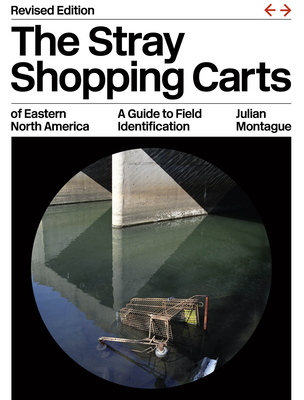
The Stray Shopping Carts of Eastern North America: A Guide to Field Identification
Description
A taxonomy we didn’t know we needed for identifying and cataloging stray shopping carts by artist and photographer Julian Montague.
Abandoned shopping carts are everywhere, and yet we know so little about them. Where do they come from? Why are they there? Their complexity and history baffle even the most careful urban explorer.
Thankfully, artist Julian Montague has created a comprehensive and well-documented taxonomy with The Stray Shopping Carts of Eastern North America. Spanning thirty-three categories from damaged, fragment, and plow crush to plaza drift and bus stop discard, it is a tonic for times defined increasingly by rhetoric and media and less by the plain objects and facts of the real world. Montague’s incomparable documentation of this common feature of the urban landscape helps us see the natural and man-made worlds—and perhaps even ourselves—anew.
First published in 2006 to great perplexity and acclaim alike, Montague’s book now appears in refreshed and expanded form. Told in an exceedingly dry voice, with full-color illustrations and photographs throughout, it is both rigorous and absurd, offering a strangely compelling vision of how we approach, classify, and understand the environments around us. A new afterword sheds light on the origins of the project.
Praise for The Stray Shopping Carts of Eastern North America: A Guide to Field Identification
"Making a case for the abandoned shopping cart as a life force in itself, designer and photographer Julian Montague's updated edition of this 2006 publication is required reading for anyone who's ever been to a grocery store."
— Hyperallergic
“As someone who worked in many grocery stores, chasing down stray carts was both a frustration and delight, depending on the day, or time, or weather. I adore Stray Shopping Carts not only for its transportive qualities, but for how it reaches for—and achieves—beauty in the examination of an object that is both beautiful and sometimes burdensome.”
— Hanif Abdurraqib
“Montague’s sly masterpiece is back, a Baedeker equal parts Ballard, Borges, and Buffalo, New York. Don’t leave home without it.”
— Ed Park, author of Same Bed Different Dreams
“A field guide to shopping carts is really a field guide to shopping: Montague’s poignant classifications reveal the often bleak, sometimes beautiful landscapes in which we acquire and dispose of goods. By the end of the book, the carts come to embody urban brokenness in a deeply human way.”
— Alexandra Lange, author of Meet Me by the Fountain
“One of the funniest books I’ve seen.”
— Stefan Sagmeister, graphic designer
“Montague’s playful taxonomy of urban blight encourages us to look closer, and look differently, at the landscape around us; to take notice, indeed celebrate, that which accumulates in the margins. In accounting for that which is overlooked or framed out, a quiet, humanizing empathy emerges.”
— Jordan Tannahill, author of The Listeners
“Thoughtfully conceived and beautifully designed, this field guide is a one-of-a-kind example of multidisciplinary engagement and originality. It’s a sociological study as much as it is a sharp eco-cultural critique of our time.”
— Giovanni Aloi, School of the Art Institute of Chicago
“The cover text. . . offers a unique vision of how we classify and understand our urban environment. It is also, of course, a playful look at one aspect of modern capitalism narrowed down to the retail industry.”
— Third Coast Review
"The unquestioned, definitive classification guide to shopping carts found in the wide world beyond their home stores or parking-lot corrals. . . . The project of classifying the carts by their condition and location—'A/2, Plaza Drift,' 'A/3, Bus Stop Discard,' 'B/13, Complex Vandalism'—is brilliantly pointless, a triumph of form without function that nevertheless got me to see my environment in a new way."
— Commonweal
